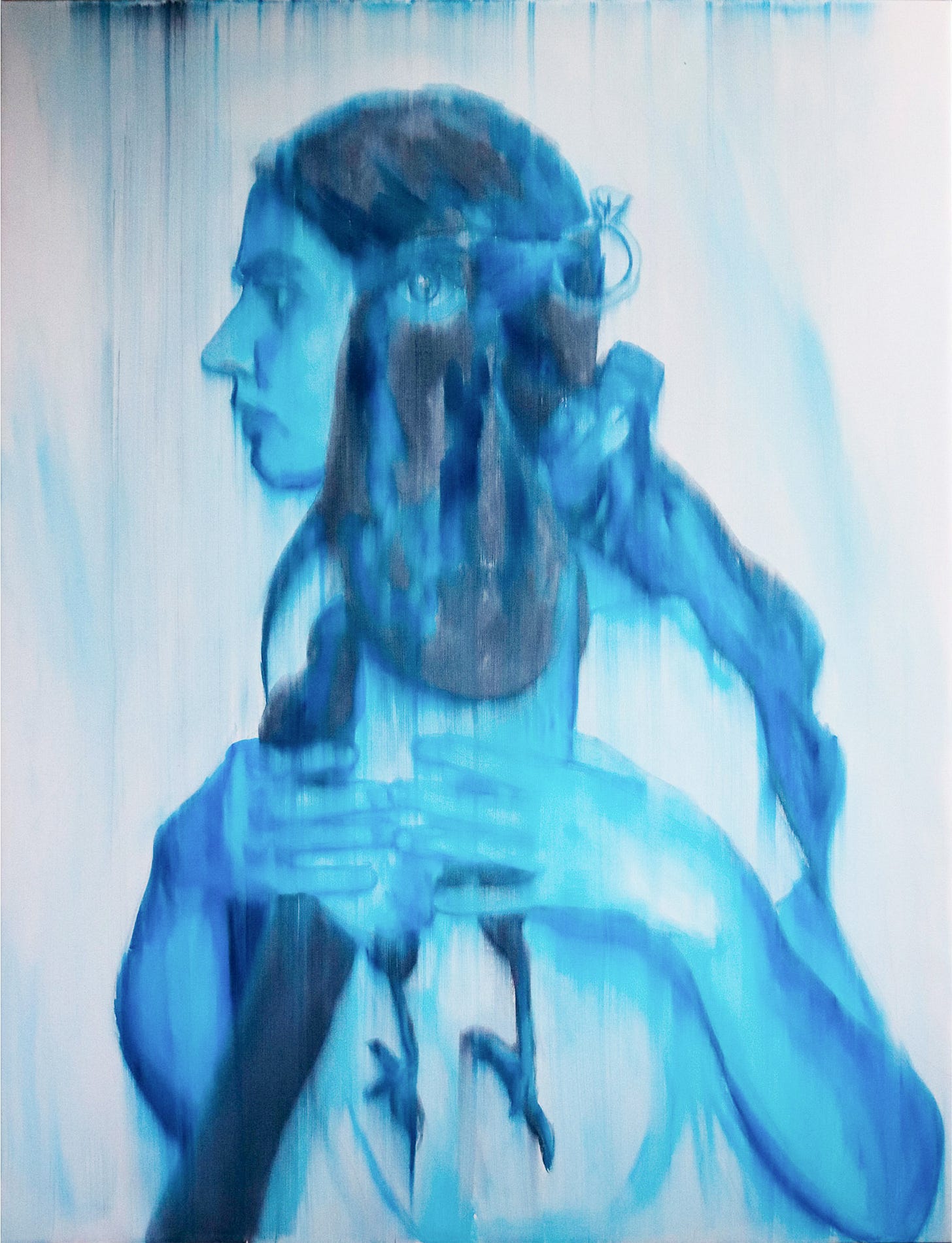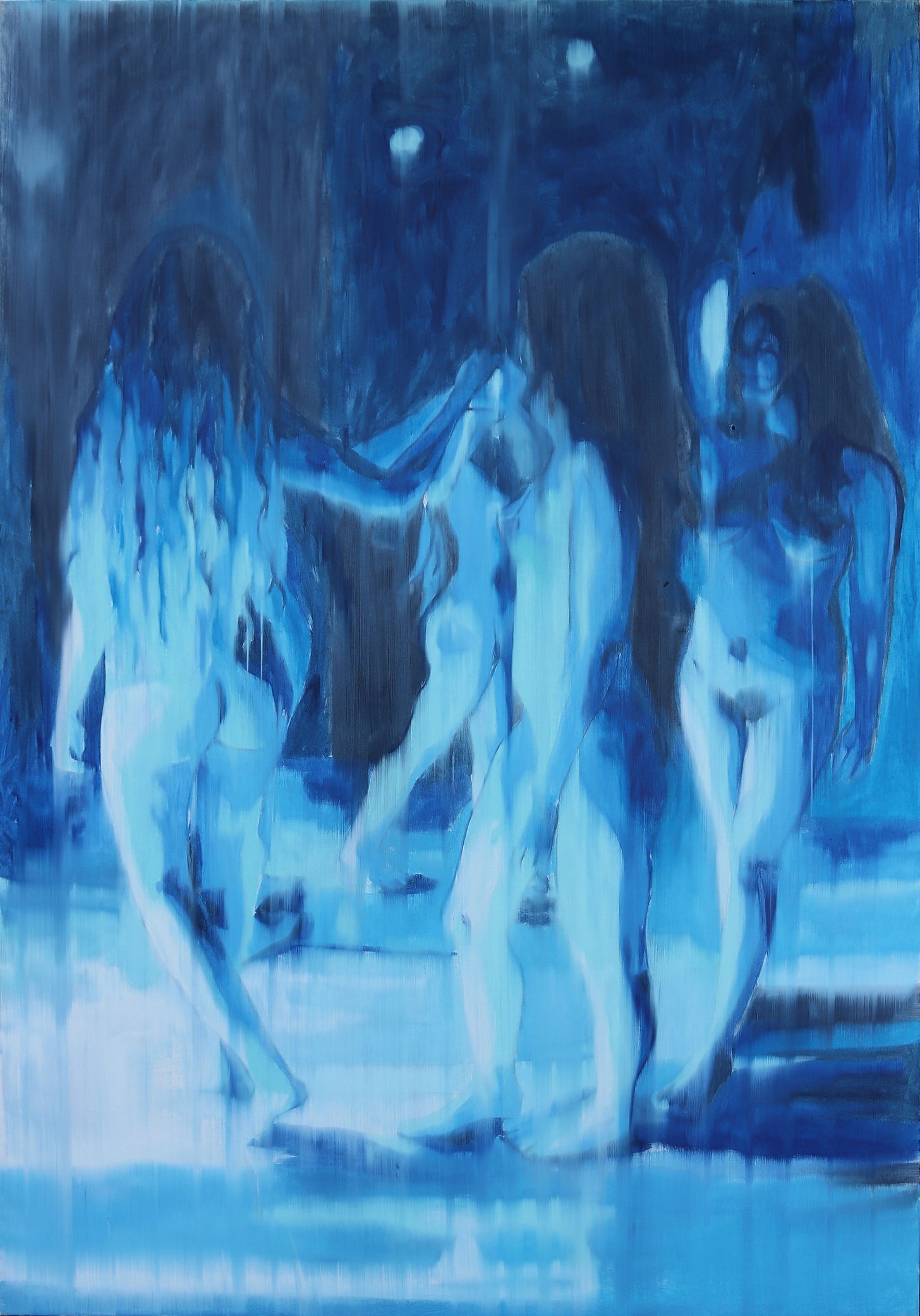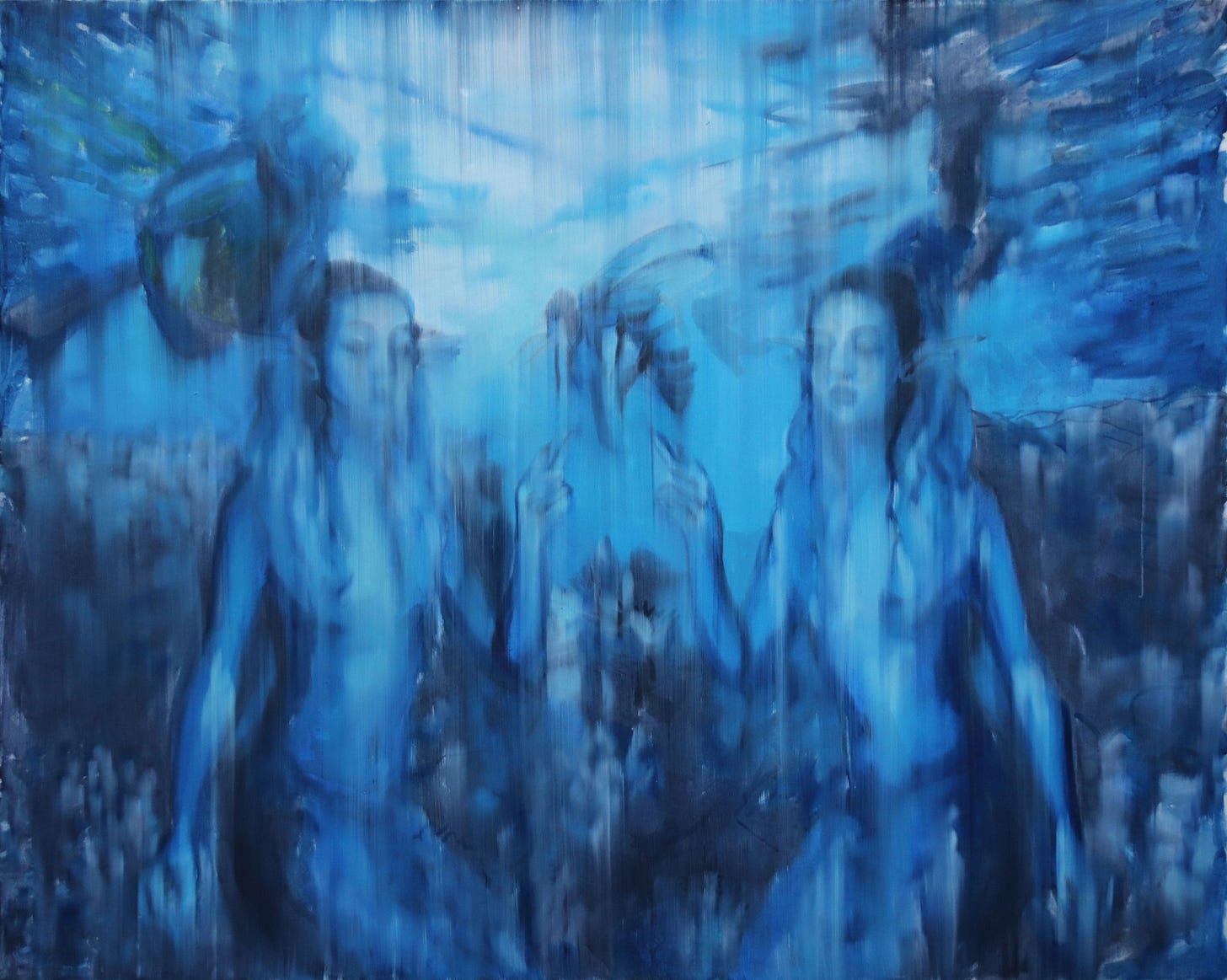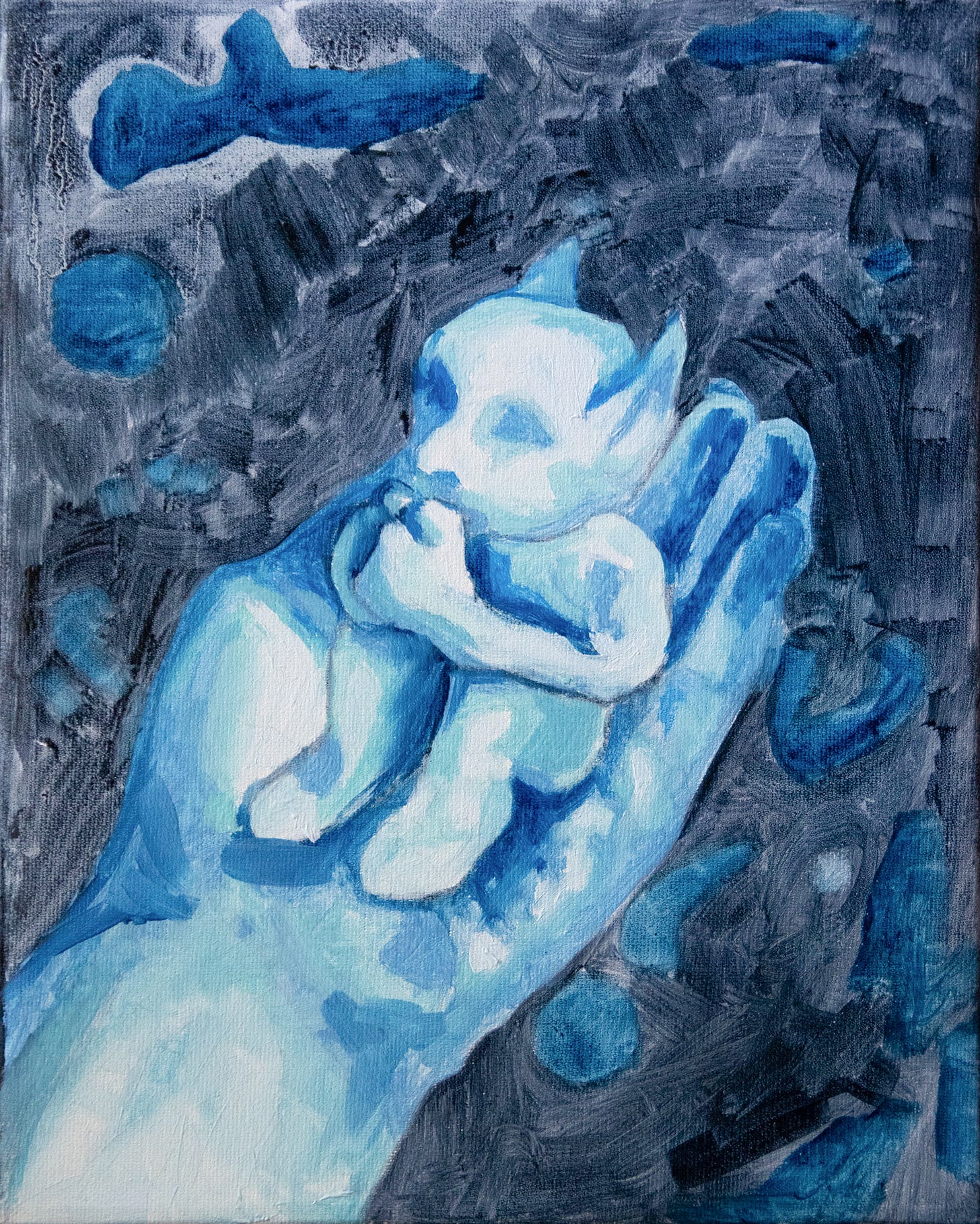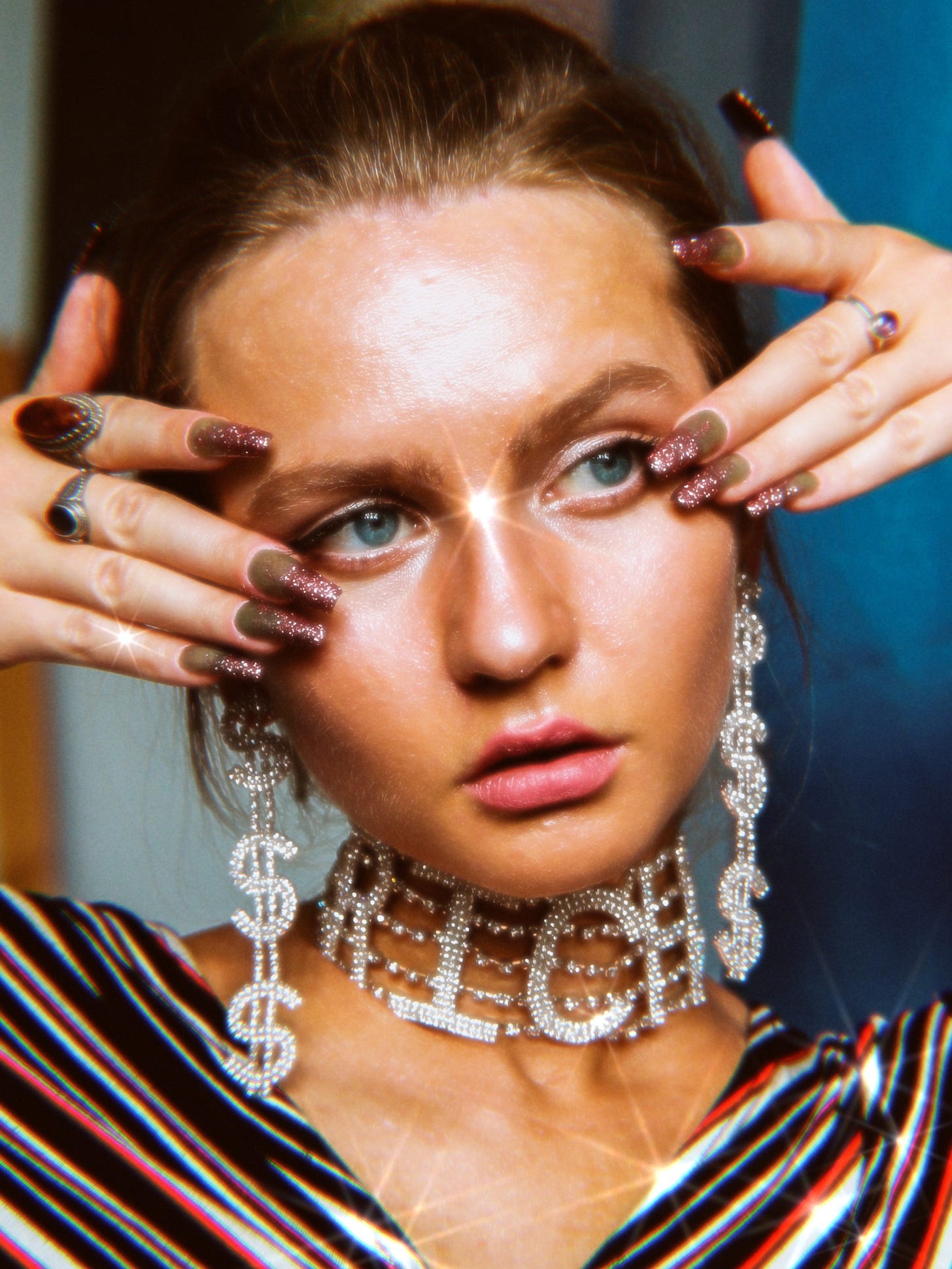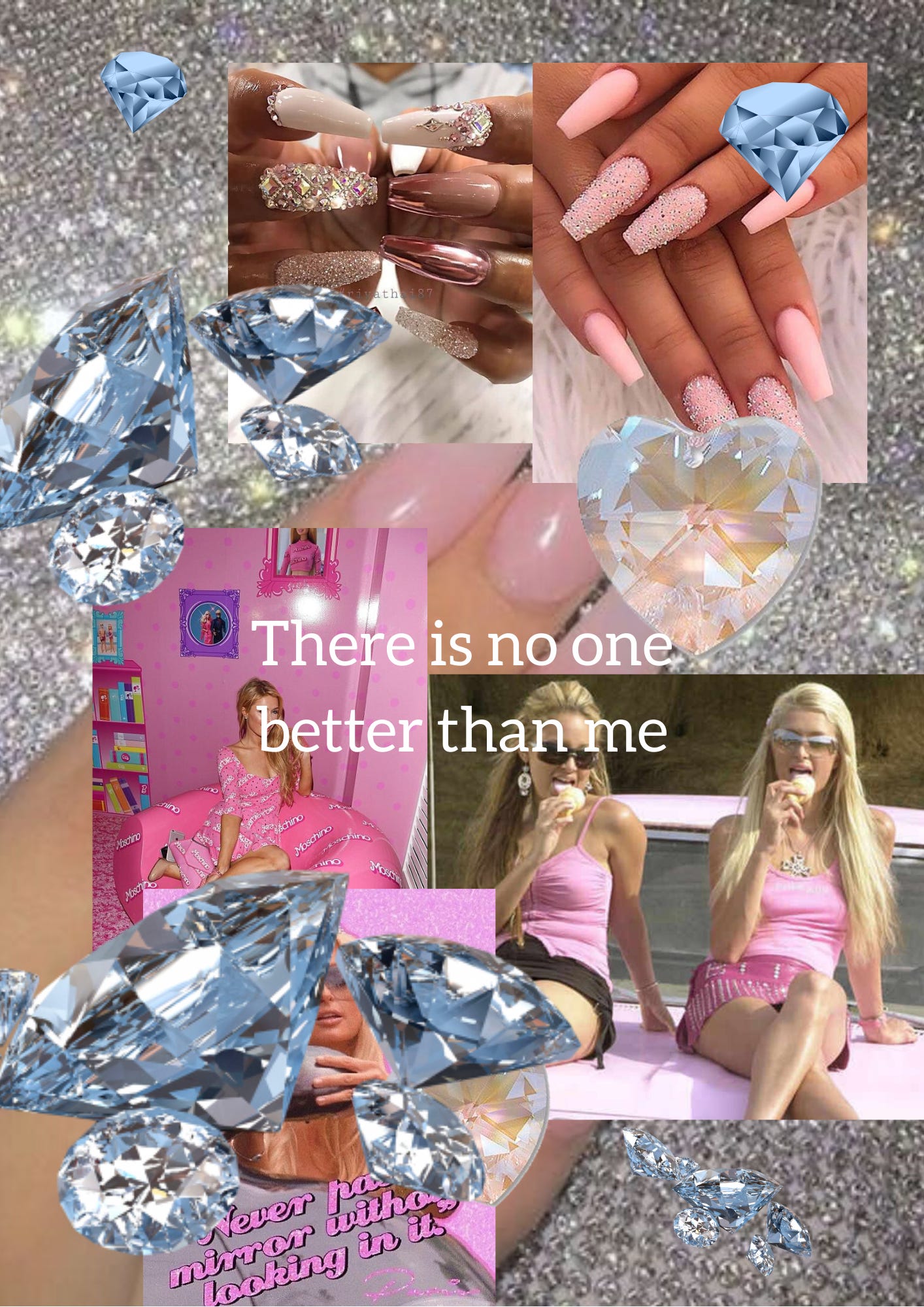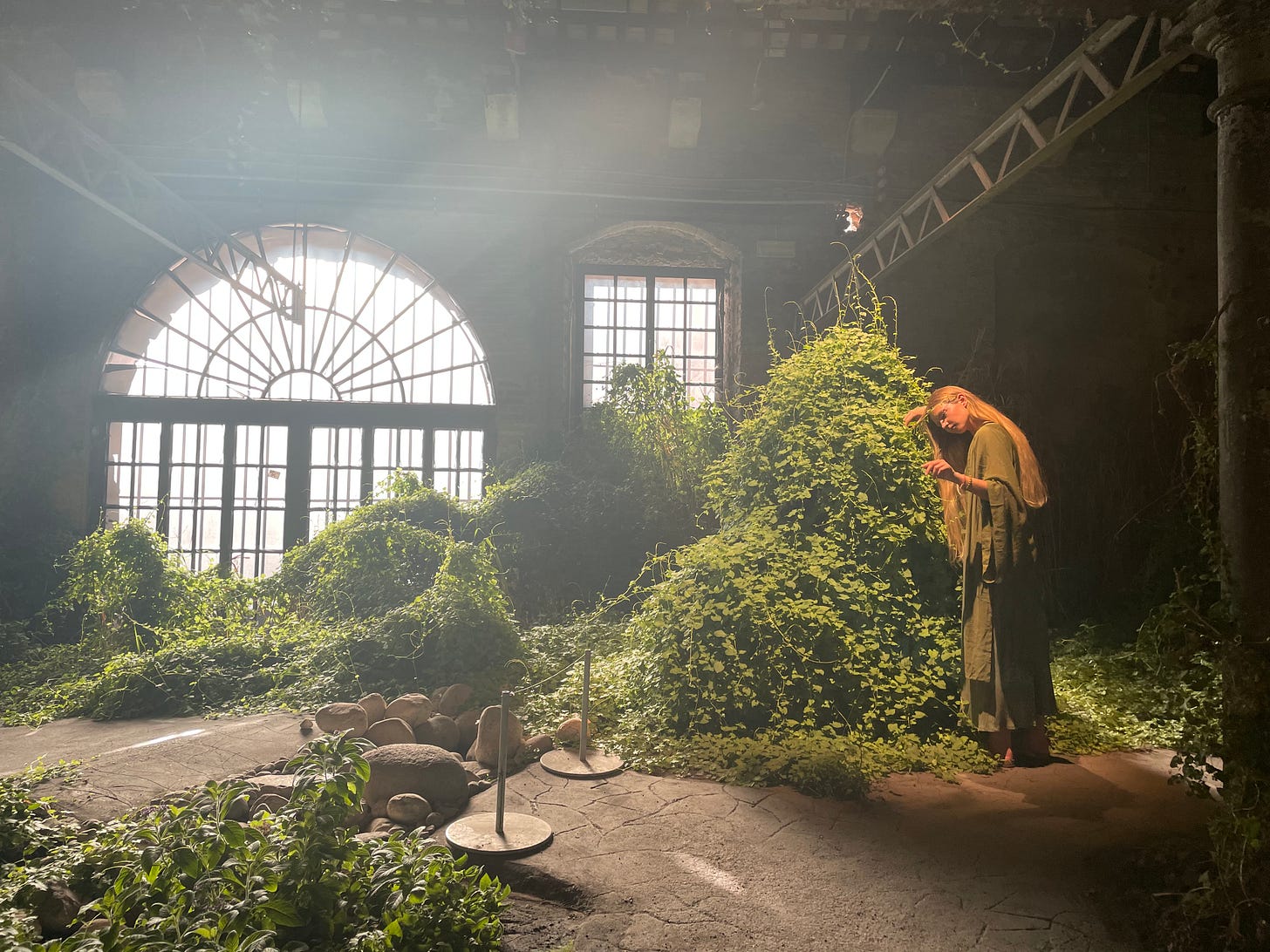Magical Worlds With No Limits
Chatting With Tarantula: Authors and Art's Artist of September, Rūta Matulevičiūtė
Shortly after flying back from our visit to the Venice Art Biennale, I met the artist Rūta Matulevičiūtė online for a conversation. A dear friend of mine, she lives in Vilnius in Lithuania while I'm calling her from Stockholm. Nowadays, distance as well as many other boundaries that contemporary artists re-examine are blurred.
In our interview Rūta talks about the inner boundaries she has experienced while studying arts; about all the clichés and opinions artists have to shake out of their minds so they can create authentically, as well as that artists do not have to suffer in order to create. Having experienced what it means to be locked in stereotypical artistic frames, this painter belonging to today's young generation says that she has reached freedom and expansion.
Rūta's overall goal is to continue self-developing, so that she can see as much of nature's beauty as possible. She starts with herself - meditating, returning to her Lithuanian roots, the fairy tales she read as a child, and the heroes of modern social networks - to create magical paintings.
To even further evolve her art, she is starting to experiment with different types of media like 3D, video or performance art in attempt to create divine worlds with no limits.
Tarantula Authors and Art: We've both just returned from the Venice Biennale. This is the second time you've seen this art show up close, what are your impressions on your return?
Ruta Matuleviciute: Two times is still really little and I don't have much to compare it to. The first impression is that you see the whole world, artists from all over the world, you get to know the whole context. Now, I have a different perspective because I have been meditating longer, I have a different understanding of art - a bit more intuitive, more attracted to real and sincere works, more repelled by works made out of pain or antics. And yet, this time, I have noticed a lot of politics in the choices of the Biennial participants. It was painful to go into some of the pavilions. For example, the Hong Kong pavilion showed historical video snippets of Soviet countries and resistance to that regime, but I saw the current situation. Other pieces that were more hopeful or looked for solutions were very appealing. For example, the Mongolian pavilion on Samsara and rebirth, the hanging sculptures by artist Munkhtsetseg Jalkhaajav, with a man on one side and a sheep on the other (part of their culture). Andrius Arutiunian's “Gharib” exhibition in the Armenian pavilion was very subtle, uplifting, divine and illuminating. There is a word for it - sublime. Ilit Azoulay's exhibition “Queendom” at the Israeli Pavilion spoke of shared cultural roots. Also, impressive was the exhibition Liquid Light by Los Angelos artist Lita Albuquerque, about souls, about rebirth. A very beautiful work.
Then there's this philosophical question - what is the purpose of an artist, to create work that speaks about today's realities, about politics, or about some more divine, otherworldly things. What is your own position?
I don't consciously touch politics in my work. Although you can't avoid news and events because you live in this world. I think that showing a problem doesn't help to solve it. My choice is to look deeper, where the problems come together and try to find the source and look for solutions there.
Since you and I met at a Transcendental Meditation Camp, I hear the influence of meditation in your words. For example, when you talk about the source of everything. How has your attitude towards art changed since you started meditating?
I've been meditating for more than three years and I haven't missed a single day because I made a promise to myself. Meditation has given me a self-awareness of who I really am. Before, all the understanding of art, the search for it, was through reading literature, listening to teachers with different opinions while I was studying in the academy, different philosophers, dead and alive, with different contexts. With meditation I discovered my true foundation. It is who I am. A leap to break free from the cages, beliefs, repetitive patterns created both among artists and in society in general. It gives access to my own perception.
Wherever we go, both in our personal lives and in our social environment, all we see are certain conventional systems and templates. In every field. You have also talked about the training of young people, which can be uplifting or traumatic. How a good teacher can inspire you or even frustrate you by putting some kind of creative template in place.
Yes, absolutely true.
Tell us your current period of work - the blue period. How was it born?
I graduated with my Master's degree in 2019 and then immediately started meditating. For another year I painted out of inertia. My fellow painters and I were trying to create a community of women artists, where the six of us had a common space, and we would create and organize events. I continued to create using the access to my work that I had from my BA and MA. And then in 2020, when corona started, I separated myself from that community because I realized that something had changed in me and my vision was no longer the same as that of my colleagues. I separated myself and started working in my grandmother's flat next to the Fairy Tale Park.
Oh what an inspiring and creative place, I had a chance to see it!
So many memories from my childhood and such a cozy environment. So my steps to change were Meditation and my grandmother's flat, which has become a creative space where so many things are important to me.
Perhaps also a certain detachment. It's good to belong to a certain group, but it's also very important to remain yourself.
Absolutely yes. It's just that it's time to realize who I am and not what I've been taught. Just by continuing the work out of inertia, I found that it didn't have that content anymore and I got exhausted. I put everything I could on the canvas and there was nothing left. I remember the last painting before I started this series - this composition of three figures of me. One of me sitting, one of me with my head in her lap, and another of me in her arms - a tiny little me with my legs crossed. After this painting I thought for some time and for a couple of weeks I did nothing but write, read and learn Vedic knowledge. Then, just as my paintings were born, the image appeared in my mind at that time too. It was as if such a flash had been illuminated. And a blue image came. A veiled woman emerged from the darkness. Oh, good, I thought. I had seen a similar motif, searched for more photographic references and made a sketch with Photoshop. I sketch on the computer, not in pencil, because I like working with photography. The image is called "Veil." It's small, maybe 20x30cm. I started to paint it with fear.
Tell me more about the fear. Was it because of the changes?
It was related to my "identity as an artist." It was already established from before. Although the blue color came from the first blue layer I had used before - underpainting, shimmering, which shone out from under all the other layers of color. But it seemed that I would now have to abandon the old technique. How would everyone react? After all, the artist has to maintain a uniform style. It was scary, but after I painted "Veil" I felt a sense of freedom, and more and more images for the blue works started to come. I started to enjoy the process, it was just wonderful, I couldn't stop and I painted a lot of paintings.
Let's go back to identity. What is it? Do we create and recreate it many times? What are your thoughts on this?
Everybody creates a character, whether they want to or not, even if they try to be open, they still create a character. Identities are constantly being created, but sometimes the changes are more obvious, more sudden, and sometimes they happen gradually and imperceptibly.
The character with which we present ourselves to society, to the world, and to ourselves at the same time, is like a piece of a puzzle. You polish the edges to fit into one place or another when you choose where you want to be. That's how you keep polishing those edges. When you see that one edge is already rotten, it's hard to take it off, because you won't fit into your previous frame anymore and you'll have to find something else. And the worst thing is when you can't even see where the next box is and you think, maybe I won't believe it anymore. Then you feel like a white crow. But it's fun to let yourself be that white crow. It's terribly hard, but it feels good because it's real.
On the other hand, you start something new. If you are not a white crow, you will not progress by holding on to that outdated piece of yourself.
Then you just follow the herd. You will do as you are supposed to do, instead of listening to yourself.
Let's talk about the symbols that you use in your work. The bee, the snake, the material, bubbles, fairy tale motifs. How are they born?
Some of the symbols come from old art and I haven't figured out what they are yet. For example, a bee or a snake are very archaic symbols that are linked to Lithuanian folklore. And they are very important to me, I see them everywhere. The bee is a sacred animal, maybe that's what attracts me. When I see something beautiful in nature, cute animals, it just makes me tear up.
Or sadness. I remember in Venice, you cried when you saw a bird dying...
Yes. But the bird was so beautiful too...
And I associate the snake with wisdom. Even though people are afraid of it, it just lives its life and does what it has to do. For Lithuanians, the snake is also a sacred animal.
I also see a lot of magical elements in your work. You talk a lot about witches, witchcraft, the unearthly, in a very playful way, as if you are enjoying and playing with that invisible world. What is it about this magical side that attracts you?
It has always seemed to me that everything we see in everyday life, everything we encounter, is just one part of what is really there. From a young age, just like your son Oscar, who reads Harry Potter and believes in the unseen, I did also. I was waiting for a letter from Hogwarts when I was eleven, but I got that letter later, in 2019, after which I started meditating.
What did the letter say?
Come to the introductory TM lecture (laughs). I don't remember in which district, but you had to take the number 7 trolley.
(we both laugh)
It seems that you still believe in magic, perhaps in another form, through the eyes of an adult. How do you think you can really influence your destiny, your creativity, your environment?
In the media, magic is shown in a very dramatic way, with big effects, hand gestures, flying, but after some time of meditation practice and learning, I got confirmation of my long-held belief that we are part of nature. The more we understand how nature works, the more we work with it, naturally, the more it helps us. The easier and faster we can achieve our goals. Magic is indeed a more natural thing than ordinary earthly life.
I am very much influenced by Lithuanian fairy tales. I find it interesting to look at your roots, where you come from, where you were born. And at the same time, my own personal encounter with fairy tales and their characters, like elves. Although there are no elves with long ears in Lithuanian culture, for me it is a character that symbolizes an open and unrestricted view of the world. Unlimited because he is different, a little bit off the ground, noticing more. I see and feel in the stories the recurring principles that are in the wisdom of all cultures. I am very attracted to those principles and I want to explore them.
You are a creator, a painter. What is the purpose of your work? After all, we do everything with a purpose - to make money, to influence others, to become famous.
I'm trying to develop myself to the point where I can see as much of the beauty of nature as possible and just show it on canvas. Nature in a broad sense, in terms of existence in general, of real and fake things, reality and ideas. That beauty, that divinity, which I feel, I want to convey, to show to other people. It is very inspiring, very empowering, it makes me wonder about the world and about life, and it encourages me to keep creating.
Did knowing that beauty starts with yourself help you in becoming yourself?
It all starts with yourself. The first thing is very simple - It's very convenient, I don't have to look for any models, I paint self-portraits. If you analyze them in detail, you don't have to look for them, because all the perceptions come from myself and from my inner growth. That is why my self-portrait-image is the most suitable for my paintings.
One of your projects, “HOT Salon”, which I personally like very much, is really very colorful. Here we see the stereotypical images of beauty, wealth, fame, but in a slightly different form - a more beautiful, non-destructive form that doesn't encourage jealousy or competition. Your role in them is more down-to-earth.
This is a Camp and Pop Art project. It's the kind of aesthetic that queer people, drag queens, use. It's quite surreal, expressive, silly, it's all very hyperbolized, very loud and dramatic. The “HOT Salon” project was born in the wake of the corona. I started to create my own kind of worlds, which happens when I get separated, and this was one of them. I was watching “Rupaul's Drag Race” all the time at the time (laughs) and I got really into it.
I'm always so into an aesthetic and I start to create my own atmosphere based on that. I loved it because it was a completely different atmosphere to what was happening in the world. I really liked the pomp, the theatrical elements. It's like in the South, even though it seems that everyday life is very poor, people have a hard time, there's nothing to eat, there's no money, there's dirt, but they just elevate their existence with a colorful outward appearance.
Painting is a very archaic art, but at the same time I see you enjoying using the latest technology. Like creating virtual galleries or videos, combining painting and visualizations.
I really like experimenting and having as many tools as possible. With each tool, the field widens for a new idea to come in and ways to fulfill it. I really like to learn everything. According to Vedic astrology, knowledge is my strength. After learning this, I realized why I like to learn different things, to go deeper and explore.
Like wanting to learn Korean, which is a language you spend time on every day.
Yes, I have been listening to Duolingo for 240 days in a row :D
Do you know how to say one sentence yet?
한국어 좋아요. 매일 공부한다. I said that I like Korean and I learn it every day.
Even while doing this interview you are wearing Chinese clothes (we laugh and take some print screen photos together).
I've been very attracted to Eastern culture since I was a kid. Chinese and Japanese philosophy have been a big influence on me. And now I'm always looking for residencies in Beijing, Seoul, etc... I don't want to be a tourist, I want to travel with my art. I want to develop artistic, cultural relations there.
What are your wishes, how do you see your creative perspective?
I want to keep painting. I like to make paintings that are static objects, but still have a lot of magic. I also want to combine painting with digital media. 3D animation, virtual reality, I want to experiment in the digital field because I see a lot of possibilities there. When I put a canvas in the studio, I have a 2D limited surface, but when I open Blender or Photoshop, there is an unlimited space in all directions, open to all dimensions. It's only as limited as the computer specs allow (laughs).
At the beginning of our conversation you mentioned the creative cage, the box you were trying to escape from, and now, correct me if I'm wrong, I see infinity, unlimited creative possibilities, surrender to experiments.
Yes, you put it very well, I agree. Endless possibilities.
Since we have talked about limitlessness and human potential in general, can you tell us what you would most like to see our creative society develop?
It always occurs to me that the most important thing for a creator is to develop himself first and then, naturally, his works will be more real and more favorable to others. It is very painful for me to see this disregard for one's own well-being, the bohemian life that is so romanticized in the movies, where a depressed artist sits on a window sill with a cigarette and a glass of wine and suffers for his life, and produces supposed masterpieces. Like Vincent Van Gogh, who at the end of his life sold one work, and 70 years after his death and the expiry of the copyright, huge money is being made from his work, presenting him as a suffering genius.
I want everyone to be free from suffering. Suffering is not necessary for creativity, it is a hindrance. I would like to see the disappearance of the notion that good art is only born of suffering. So far, cynicism somehow seems more serious than positivity. And that positivity seems naive.
Or talking about politics seems more serious than photographing flowers. This brings us both back to the Venice Biennale, where you said that some works repress you and others uplift you, liberate you.
The state the artist was in when he or she were making the work is immediately transferred into the work. That is the great responsibility of every artist - not to spread rubbish. To spread goodness.
Let's wish that to everyone, thank you Rūta.
To see more of Rūta Matusevičiūtė’s work you can visit her website rutavm.com or @ruta_matuleviciute on Instagram. Also, check out her work-in-progress Hot Salon!


